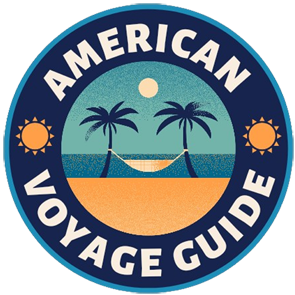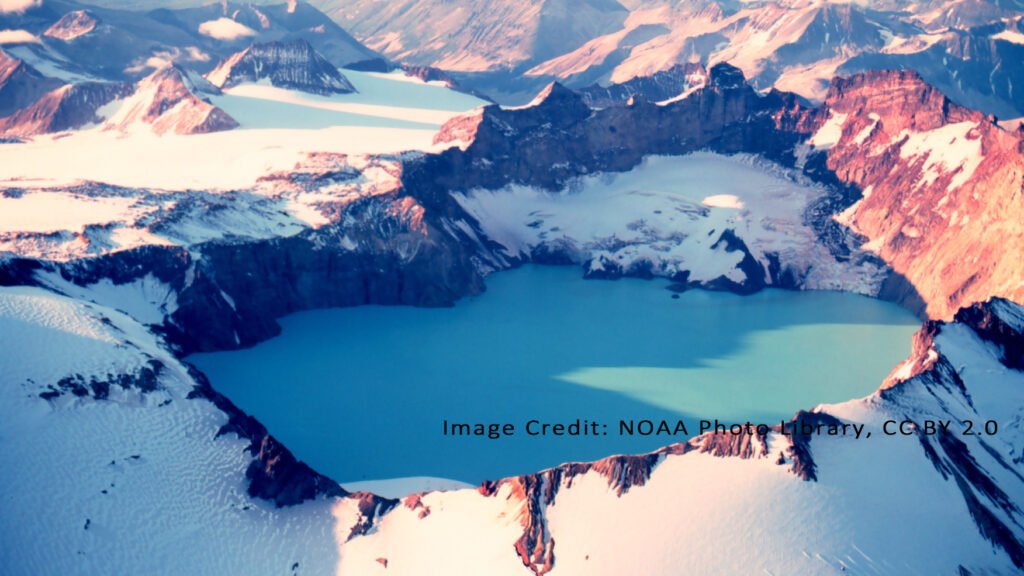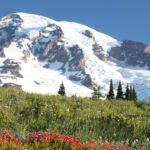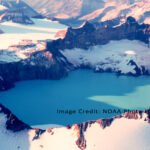Explore Katmai National Park in Alaska with our complete guide on bear viewing at Brooks Falls, hiking trails, top travel tips, and the best time to visit this wildlife wonderland.
Table of Contents
1. Introduction to Katmai National Park
Tucked away in the rugged wilderness of southern Alaska, Katmai National Park and Preserve is a paradise for nature lovers, wildlife enthusiasts, and adventurers. Covering over 4 million acres of breathtaking landscapes, this remote gem is renowned for its brown bear viewing opportunities, volcanic terrains, and pristine rivers teeming with salmon. If you’ve ever dreamed of watching bears in their natural habitat, Katmai National Park bear viewing at Brooks Falls offers a front-row seat to one of the most iconic wildlife spectacles in the world.
Established in 1918, Katmai was initially designated to protect the area following the dramatic eruption of Novarupta volcano and the creation of the Valley of Ten Thousand Smokes. Today, it has evolved into a symbol of untouched beauty and thriving ecosystems. The park’s remote location ensures a quiet, immersive experience away from the bustling crowds of more mainstream destinations.
2. How to Get to Katmai National Park
Step 1: Fly to Anchorage, Alaska
Your journey begins with a flight to Ted Stevens Anchorage International Airport (ANC), the main gateway to Alaska. Anchorage serves as a hub for domestic and international travelers, making it the first stop on your way to Katmai.
- Tip: Most major airlines offer flights to Anchorage year-round, but summer (June to September) is the peak season for travelers heading to Katmai for brown bear viewing at Brooks Falls.
Step 2: Take a Flight to King Salmon
From Anchorage, the next leg of your journey involves a short flight to King Salmon, a small town located approximately 290 miles southwest of Anchorage.
- Flight Duration: Around 1 hour.
- Airlines: Regional carriers like Alaska Airlines and smaller charter services operate daily flights to King Salmon during the summer months.
- Why King Salmon? King Salmon is the closest town to Katmai National Park and serves as the primary access point for visitors.
Step 3: Charter a Floatplane to Katmai National Park
Once you arrive in King Salmon, you’ll need to arrange a floatplane or water taxi to enter Katmai National Park, as there are no roads connecting the town to the park.
- Brooks Camp Access: The most popular destination within the park is Brooks Camp, where visitors can enjoy the iconic Katmai National Park bear viewing at Brooks Falls. Floatplanes frequently land on Naknek Lake, just steps away from Brooks Camp.
- Flight Duration: Around 20-30 minutes from King Salmon to Brooks Camp.
- Operators: Several local air taxi services, such as Katmai Air and Branch River Air, offer scenic flights to Brooks Camp and other parts of the park.
Alternative Routes to Katmai National Park
For those looking for more adventurous or scenic routes:
- Boat Charter: While less common, boat charters are available from King Salmon to the park. This option is slower but allows you to take in the stunning views of the Alaskan wilderness and waterways.
- Guided Tours: Many tour operators offer packages that include flights, accommodation, and guided excursions. These tours often streamline the logistics of getting to Katmai, making it a stress-free option for first-time visitors.
Getting Around Katmai National Park
Once you arrive at Katmai, getting around the park is primarily done on foot, by boat, or via floatplane. Brooks Camp serves as a central hub for visitors, offering access to hiking trails, bear viewing platforms, and camp facilities. For exploring remote areas like the Valley of Ten Thousand Smokes or other hiking trails, guided tours or chartered flights are the best options.
Travel Tips for Visiting Katmai
- Book Early: Flights to King Salmon and floatplane charters to Brooks Camp fill up quickly, especially during the peak bear viewing months of July and September.
- Pack Light: Floatplanes have weight limits, so pack only essential gear, clothing, and cameras.
- Plan for Weather: Weather in Alaska can be unpredictable, causing occasional delays for flights. Plan your itinerary with flexibility.
3. Best Time to Visit Katmai National Park
Bear Viewing at Brooks Falls: Peak Months
Katmai is renowned for its world-class bear viewing, and Brooks Falls is the prime location to witness these majestic creatures catching salmon. The salmon runs, which attract the brown bears, occur in distinct waves during the summer:
- July (Salmon Run Peak):
- July is the best month to see brown bears in action at Brooks Falls. During this time, salmon migrate upstream to spawn, leaping through the waterfalls, while dozens of bears gather to feast on the fish.
- The combination of bear activity, clear skies, and warm temperatures makes July the most popular and busiest time to visit.
- Tip: Book accommodations and floatplane flights to Brooks Camp well in advance, as demand is extremely high.
- September (Salmon Spawn):
- In September, bears return to the rivers to catch dying and exhausted salmon as they complete their spawning cycle. While the bear activity is slightly less concentrated than in July, the fall scenery—vivid autumn colors and cooler temperatures—makes for a breathtaking backdrop.
- Photographers especially enjoy September for its dramatic light and stunning landscapes.
Seasonal Guide to Katmai National Park
- June (Early Summer):
June marks the start of the bear viewing season as salmon begin to appear in the rivers. While bear numbers are lower compared to July, the park is quieter, offering a more peaceful experience for visitors. This is a great time for hiking and exploring other areas, such as the Valley of Ten Thousand Smokes, with fewer crowds. - July and August (Peak Summer):
These months offer the best time to visit Katmai National Park for guaranteed bear sightings at Brooks Falls. The warm temperatures, long daylight hours, and peak salmon runs attract the highest concentration of bears, making it the most exciting and vibrant time in the park. - September (Early Fall):
As summer transitions to fall, Katmai transforms into a colorful wilderness. Bear viewing is excellent as they prepare for winter hibernation, and the cooler weather makes hiking and fishing more comfortable. This is also a quieter alternative to the summer rush, perfect for those seeking a less crowded experience. - October to May (Off-Season):
During the winter months, Katmai National Park is blanketed in snow, and bear activity ceases as they hibernate. The park becomes less accessible, and tourism drops significantly. However, adventurous travelers can still visit for backcountry skiing, snowshoeing, or solitude.
Weather Conditions to Consider
Katmai’s weather can be unpredictable, so it’s important to plan for a variety of conditions:
- Summer Temperatures: Ranges between 50°F to 70°F (10°C to 21°C). Expect occasional rain and wind, so pack layers and waterproof gear.
- Fall Temperatures: Cooler temperatures around 40°F to 60°F (4°C to 15°C).
- Winter Temperatures: Often drop below freezing, making travel challenging.
Wildlife Viewing Beyond Bears
While bears are the main attraction, summer is also the best time to spot other wildlife in Katmai, such as bald eagles, wolves, moose, and foxes. The rivers and lakes are alive with salmon and trout, attracting both anglers and photographers.
Summary: When to Visit Katmai
- July: Best for bear viewing at Brooks Falls during the salmon run.
- September: Ideal for fewer crowds, fall foliage, and bear activity as they prepare for winter.
- June: Early season with quieter trails and wildlife starting to emerge.
For visitors looking to experience Katmai National Park bear viewing at its peak, July and September are unbeatable. However, each season offers its own unique charm, making Katmai a year-round adventure for those seeking an unforgettable Alaskan wilderness experience.
Click here to visit the official park website.
4. Top Things to Do in Katmai National Park
1. Bear Viewing at Brooks Falls
One of the most iconic experiences in Katmai is brown bear viewing at Brooks Falls. This is the main reason most visitors come to the park, and it’s truly a sight to behold.
- What to Expect: During the summer salmon runs in July and September, dozens of brown bears gather at Brooks Falls to catch leaping salmon. The bear viewing platforms offer safe and unobstructed views, perfect for observing and photographing these incredible animals in their natural habitat.
- Best Time to Visit: July is peak bear viewing season when the salmon runs are at their highest. September offers quieter crowds and dramatic fall scenery.
- Tips: Be patient and bring a good camera. It’s common to see bears fishing, playing, and interacting with each other.
2. Explore the Valley of Ten Thousand Smokes
The Valley of Ten Thousand Smokes is a must-see for adventure lovers and history buffs. This vast, volcanic landscape was created by the massive eruption of Novarupta in 1912, one of the largest eruptions in recorded history.
- What to Expect: The valley features ash-covered terrain, deep canyons, and stunning views of volcanic formations. Guided tours from Brooks Camp take visitors to this fascinating area, where you can hike through the valley and learn about its geological history.
- Top Hike: A popular trail is the hike down to the Ukak River, where you can explore the ash fields up close.
- Why Visit: This otherworldly landscape offers a unique contrast to the lush rivers and forests of Katmai, showcasing the park’s diversity.
3. Hiking Trails in Katmai National Park
For hikers, Katmai offers a variety of trails that cater to all skill levels. While the park is known for its remote wilderness, several accessible hikes allow you to explore its scenic beauty on foot.
- Dumpling Mountain Trail:
- Length: 4 miles round trip.
- What to Expect: This moderate trail near Brooks Camp rewards hikers with panoramic views of Naknek Lake, Brooks River, and the surrounding mountains. On a clear day, it’s a stunning spot for photography.
- Valley of Ten Thousand Smokes Hike:
- For more experienced hikers, guided tours through the valley offer a full-day trek into the volcanic landscape.
- Tips for Hiking:
- Always carry bear spray and make noise as you hike to avoid surprising wildlife.
- Dress in layers and prepare for changing weather conditions.
4. Fishing Adventures
Katmai is a dream destination for anglers, with its pristine rivers and lakes teeming with fish. The park’s rivers are famous for their salmon runs, attracting both bears and fishing enthusiasts.
- What to Fish: King salmon, sockeye salmon, rainbow trout, and Arctic char are some of the most sought-after catches.
- Top Fishing Spots: Brooks River is one of the most popular spots for fishing, offering incredible opportunities to catch trophy-sized trout and salmon.
- Tips:
- Fishing is regulated to protect the ecosystem, so ensure you have the necessary permits.
- Be aware of nearby bears and follow all safety guidelines for fishing in bear country.
5. Wildlife Watching and Photography
Beyond the famous brown bears, Katmai National Park is home to diverse wildlife, making it a paradise for photographers and nature enthusiasts.
- Wildlife to Look For:
- Bald eagles soaring above the rivers.
- Wolves and moose roaming the backcountry.
- River otters, foxes, and a variety of bird species.
- Photography Tips:
- The best time for wildlife photography is during the early morning or late evening when animals are most active, and the lighting is soft.
- Use a telephoto lens to capture close-up shots while maintaining a safe distance.
6. Camping and Backcountry Adventures
For those who want to fully immerse themselves in Katmai’s wilderness, camping and backcountry adventures are the perfect way to experience the park’s solitude.
- Brooks Camp: The most popular campground, located near Brooks Falls, allows visitors to stay close to the action. Reservations are required well in advance during peak bear season.
- Backcountry Camping: Katmai’s vast wilderness offers endless opportunities for experienced campers to explore remote areas. Always follow Leave No Trace principles and be prepared for bear encounters.
- Safety Tip: Katmai is bear country. Store all food and scented items in bear-proof containers, and stay alert at all times.
7. Scenic Flights Over Katmai
One of the most unique ways to see the park’s expansive beauty is by taking a scenic flight. From above, you’ll witness the dramatic landscapes of volcanic valleys, turquoise lakes, and winding rivers.
- Highlights:
- Aerial views of Brooks Falls with bears fishing for salmon.
- The otherworldly landscapes of the Valley of Ten Thousand Smokes.
- Snow-capped peaks, glaciers, and vibrant ecosystems that stretch for miles.
- Why It’s Worth It: Scenic flights provide a once-in-a-lifetime perspective of Katmai’s raw, untouched wilderness that’s hard to appreciate fully from the ground.
5. Wildlife in Katmai National Park
The Famous Brown Bears of Katmai
Katmai is best known for its brown bears, which are among the largest in the world. With an estimated population of over 2,000 bears, the park provides one of the most concentrated and easily observable bear habitats on the planet.
Where to See Brown Bears
- Brooks Falls: This is the most famous spot for Katmai bear viewing, where bears gather during the summer months to catch salmon as they leap upstream. Watching these powerful animals skillfully fish at Brooks Falls is an unforgettable experience.
- Brooks River: Aside from the falls, the entire Brooks River is a hotspot for bears, especially during the salmon run. Bears can be seen swimming, hunting, and interacting along the riverbanks.
- Coastal Areas: Bears are also spotted in coastal regions of Katmai, like Hallo Bay, where they forage for clams, sedge grass, and other food sources.
Best Time for Bear Viewing
- July: During the peak salmon run, bears gather in large numbers at Brooks Falls, providing incredible opportunities to observe and photograph them.
- September: Bears return to feast on exhausted salmon as they complete their spawning cycle. Fall foliage adds a stunning backdrop for wildlife viewing.
Salmon: The Lifeblood of Katmai’s Ecosystem
The annual salmon migration is central to the park’s ecosystem, sustaining both wildlife and the environment. Katmai’s rivers, such as the Brooks River and Naknek River, teem with millions of salmon during the summer months, attracting brown bears, bald eagles, and other predators.
- Species of Salmon in Katmai:
- Sockeye Salmon (most abundant)
- King Salmon
- Coho Salmon
- Pink Salmon
The salmon run not only fuels the survival of bears but also supports other wildlife, including river otters, wolves, and scavenging birds.
Other Mammals in Katmai National Park
While brown bears steal the spotlight, Katmai is also home to a variety of other mammals that thrive in its diverse habitats:
- Wolves: Often elusive, wolves roam the backcountry in search of prey, playing an essential role in maintaining the park’s ecological balance.
- Moose: These large, solitary herbivores are typically seen grazing near lakes, rivers, and wetlands. Look for them around Naknek Lake or the Brooks River area.
- Foxes: Both red and arctic foxes inhabit the park, often spotted hunting for small mammals or scavenging along the riverbanks.
- River Otters: Playful and energetic, river otters are frequently seen along the waterways, especially during early morning or dusk.
Bird Watching in Katmai
Katmai’s rivers, lakes, and coastal areas provide rich habitats for birdlife, making it a paradise for bird watchers. The park is home to both resident and migratory bird species, with opportunities to spot them year-round.
- Key Bird Species in Katmai:
- Bald Eagles: Common throughout the park, bald eagles are often seen perched in trees near rivers or swooping down to catch salmon.
- Puffins: Found along the park’s coastal cliffs, puffins are a favorite among bird enthusiasts.
- Tundra Swans and Ducks: Wetlands and lakes host a variety of waterfowl, including tundra swans, mallards, and goldeneyes.
- Gulls and Shorebirds: Coastal areas, such as Hallo Bay, are ideal for spotting gulls, sandpipers, and other shorebirds.
Marine Life and Coastal Wildlife
The coastal areas of Katmai, particularly along the Shelikof Strait and Hallo Bay, are home to a variety of marine wildlife:
- Sea Otters: Often seen floating in kelp beds or near shorelines, sea otters are a favorite among visitors.
- Harbor Seals and Sea Lions: These marine mammals can be spotted sunbathing on rocky beaches or swimming near coastal waters.
- Whales: The coastal waters near Katmai occasionally host humpback whales, orcas, and gray whales, especially during their seasonal migrations.
6. Where to Stay in Katmai National Park
1. Brooks Lodge
Brooks Lodge is the most popular and well-known lodging option within Katmai National Park. Located near Brooks Falls, it offers unparalleled access to the world-famous brown bear viewing spots, making it the top choice for wildlife enthusiasts and photographers.
- Location: Brooks Camp, a short walk from the bear viewing platforms at Brooks Falls.
- Accommodation: Rustic but comfortable cabins that can accommodate up to 4 people. Bathrooms and dining facilities are shared.
- Amenities:
- Guided tours to Brooks Falls and the Valley of Ten Thousand Smokes.
- On-site dining, offering hearty meals after a day of adventure.
- Fishing equipment rentals for visitors wanting to fish in the salmon-filled Brooks River.
- Why Stay Here: Brooks Lodge offers the closest access to the bear viewing platforms, allowing you to spend hours watching and photographing bears.
- Booking Tip: Reservations are in high demand, especially during peak bear season (July and September). Book your stay up to a year in advance to secure a spot.
2. Katmai Wilderness Lodge
For travelers seeking a more secluded and intimate experience, Katmai Wilderness Lodge offers an all-inclusive stay in the heart of Alaska’s pristine coastal wilderness.
- Location: Located along the park’s coastline in Kukak Bay, accessible only by floatplane.
- Accommodation: Cozy, private cabins equipped with modern comforts while maintaining a wilderness feel.
- Amenities:
- All-inclusive packages with meals, guided wildlife excursions, and bear viewing tours.
- Scenic boat tours along the coastline to observe marine wildlife, including sea otters and whales.
- Opportunities for hiking, fishing, and beachcombing.
- Why Stay Here: The lodge provides an exclusive experience for small groups, away from the crowds at Brooks Camp. It’s ideal for those looking to combine bear viewing with marine wildlife exploration.
3. Grosvenor Lodge
Grosvenor Lodge is a remote and quiet destination located near the park’s lakes and rivers, offering a perfect base for fishing enthusiasts and nature lovers.
- Location: Situated between Grosvenor Lake and Naknek Lake, accessible via floatplane from King Salmon.
- Accommodation: Rustic cabins that provide basic comforts in a serene and isolated setting.
- Amenities:
- Guided fishing trips to catch trophy-sized trout and salmon.
- Wildlife watching opportunities, including bears, moose, and bald eagles.
- Fully catered meals and guided activities.
- Why Stay Here: With its focus on fishing and tranquil surroundings, Grosvenor Lodge is perfect for those who want a quieter, off-the-beaten-path experience.
4. Camping at Brooks Camp
For visitors looking to experience Katmai National Park on a budget or immerse themselves more deeply in nature, camping at Brooks Camp is an excellent option.
- Location: Near Brooks River, close to the bear viewing platforms and Brooks Lodge.
- Facilities:
- Designated camping areas with bear-safe food storage and electric fences for safety.
- Access to shared bathrooms and water stations.
- Why Stay Here: Camping at Brooks Camp offers a front-row seat to the park’s bear activity at an affordable price. It’s also the best way to experience Katmai’s wilderness up close while staying safe.
- Important Tips:
- Reservations are required due to high demand during peak summer months.
- Follow all bear safety protocols provided by park rangers, including storing food securely and remaining alert.
5. Backcountry Camping in Katmai
For adventurous travelers seeking solitude and a true wilderness experience, backcountry camping is a great option. Katmai’s vast landscapes, from volcanic valleys to remote coastlines, provide endless opportunities for exploration.
- Where to Camp: Backcountry camping is permitted throughout the park, but popular areas include the Valley of Ten Thousand Smokes, Hallo Bay, and remote riverbanks for fishing and wildlife watching.
- What to Expect: No amenities—campers must bring all food, supplies, and gear. Leave No Trace principles are strictly enforced to preserve the park’s pristine environment.
- Safety Considerations:
- Always carry bear spray and a bear-proof food container.
- Be prepared for unpredictable weather and navigation challenges in this remote terrain.
- Notify park rangers of your plans and travel routes for safety.
- Why Choose Backcountry Camping: It’s the ultimate way to immerse yourself in Katmai’s untouched wilderness and enjoy solitude away from the crowds.
6. Lodging in King Salmon
For visitors unable to secure accommodation inside the park, the nearby town of King Salmon serves as the primary gateway to Katmai National Park.
- Options Available: King Salmon offers lodges, hotels, and bed-and-breakfasts catering to travelers waiting to catch floatplanes into the park.
- Why Stay Here: It’s a convenient option for those planning day trips or scenic flights into Katmai. Visitors can also enjoy fishing and wildlife viewing in the surrounding area.
Choosing the Best Accommodation in Katmai
Whether you opt for the rustic charm of Brooks Lodge, a secluded coastal retreat at Katmai Wilderness Lodge, or the adventurous thrill of backcountry camping, each option in Katmai National Park offers a unique way to experience its wild beauty.
- For bear viewing, staying at Brooks Lodge or Brooks Camp is ideal.
- For a peaceful escape and coastal wildlife adventures, choose Katmai Wilderness Lodge.
- If fishing is your main goal, Grosvenor Lodge is perfect.
- Adventurous travelers will love the freedom of backcountry camping.
You may also like Explore Glacier Bay National Park: Your Ultimate Guide to Alaska’s Pristine Wilderness
7. Tips for Visiting Katmai National Park
- Book Early: Lodges like Brooks Lodge and campgrounds fill up fast, especially during peak bear-viewing months (July and September).
- Getting There: Fly to King Salmon and then take a floatplane to Brooks Camp. Allow extra time for weather-related delays.
- Bear Safety: Keep a safe distance (50 yards), carry bear spray, and store food securely to avoid bear encounters.
- Pack Wisely: Bring waterproof clothing, sturdy boots, insect repellent, and a good camera for wildlife photography.
- Leave No Trace: Respect the environment, follow designated trails, and pack out all trash.
- Timing: Visit in July or September for prime bear viewing and better weather.
- Limited Services: Expect no cell service or stores; bring all essentials, including snacks and first aid supplies.
Katmai National Park and Preserve is a true Alaskan gem, offering an unparalleled opportunity to witness nature at its most raw and beautiful. From the iconic brown bear viewing at Brooks Falls to the dramatic landscapes of the Valley of Ten Thousand Smokes, this remote wilderness promises unforgettable adventures for every visitor. Whether you’re a wildlife enthusiast, a fishing fanatic, or a nature lover seeking solitude, Katmai delivers experiences you’ll treasure forever. Plan carefully, respect the environment, and embrace the journey—because a trip to Katmai is more than a vacation; it’s a once-in-a-lifetime experience.







